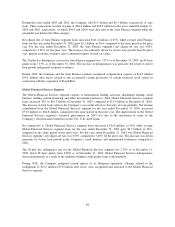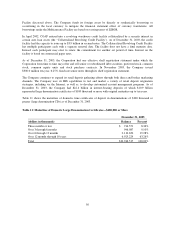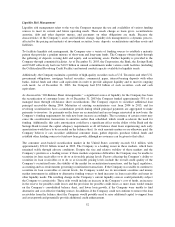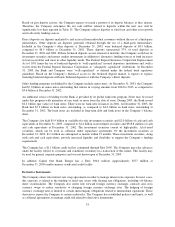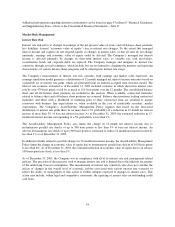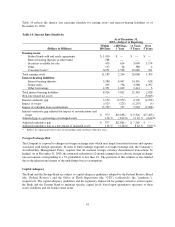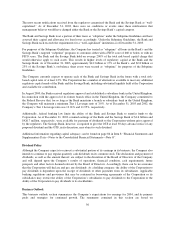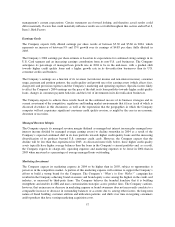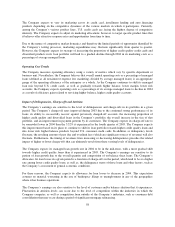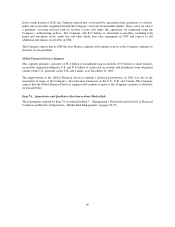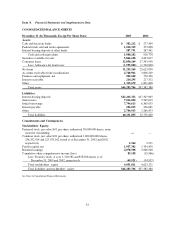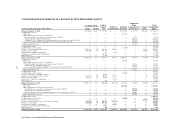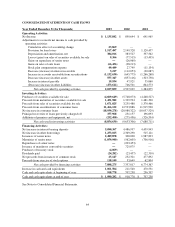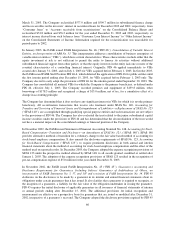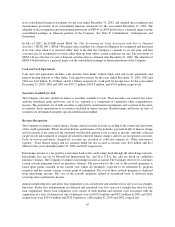Capital One 2003 Annual Report Download - page 76
Download and view the complete annual report
Please find page 76 of the 2003 Capital One annual report below. You can navigate through the pages in the report by either clicking on the pages listed below, or by using the keyword search tool below to find specific information within the annual report.The Company expects to vary its marketing across its credit card, installment lending and auto financing
products depending on the competitive dynamics of the various markets in which it participates. Currently,
among the Company’s various product lines, U.S. credit cards are facing the highest degree of competitive
intensity. The Company expects to adjust its marketing allocations, however, to target specific product lines that
it believes offer attractive response rates and opportunities from time to time.
Due to the nature of competitive market dynamics and therefore the limited periods of opportunity identified by
the Company’s testing processes, marketing expenditures may fluctuate significantly from quarter to quarter.
However, the Company expects its strategy of increasing the proportion of higher credit quality credit cards and
diversified products in its loan portfolio will lead to a gradual decline through 2004 in its marketing costs as a
percentage of average managed loans.
Operating Cost Trends
The Company measures operating efficiency using a variety of metrics which vary by specific department or
business unit. Nevertheless, the Company believes that overall annual operating costs as a percentage of managed
loans (defined as all non-interest expense less marketing, divided by average managed loans) is an appropriate
gauge of the operating efficiency of the enterprise as a whole. As the Company continues to shift its managed
loan mix beyond U.S. credit cards, as well as gradually towards higher balance, lower margin, lower risk
accounts, the Company expects operating costs as a percentage of its average managed loans to decline in 2004
as a result of efficiency gains related to servicing higher balance, higher credit quality accounts.
Impact of Delinquencies, Charge-offs and Attrition
The Company’s earnings are sensitive to the level of delinquencies and charge-offs in its portfolio in a given
period. The Company’s charge-off rates improved during 2003 due to the continued strong performance of its
loans, its ability to successfully recover against previously charged-off accounts, the increasing proportion of
higher credit quality and diversified loans in the Company’s portfolio, the overall increase in the size of that
portfolio, and an improvement in payment patterns by its customers. The Company expects its charge-off rate to
be somewhat lower in 2004 than the 5.32% it experienced in the fourth quarter of 2003. The Company expects
this improvement based on its plans to continue to shift its loan portfolio towards higher credit quality loans and
into lower risk, higher balance products beyond U.S. consumer credit cards. In addition, as delinquency levels
fluctuate, the resulting amount of past due and overlimit fees (which are significant sources of revenue) will also
fluctuate. Furthermore, the timing of revenues from increasing or decreasing delinquencies precedes the related
impact of higher or lower charge-offs that can ultimately result from these varying levels of delinquencies.
The Company expects its managed loan growth rate in 2004 to be in the mid-teens, with a more gradual shift
towards higher credit quality loans than it experienced in 2003. The Company’s earnings are sensitive to its
pattern of loan growth due to the overall quantity and composition of on-balance sheet loans. The Company’s
allowance for loan losses in a given period is a function of charge-offs in the period, which tend to be at a higher
rate among lower credit quality loans, as well as, the delinquency status of those loans and other factors, such as
the Company’s assessment of general economic conditions.
For these reasons, the Company expects its allowance for loan losses to decrease in 2004. This expectation
assumes no material worsening in the rate of bankruptcy filings or unemployment in any of the geographies
where it has business operations.
The Company’s earnings are also sensitive to the level of customer and/or balance attrition that it experiences.
Fluctuation in attrition levels can occur due to the level of competition within the industries in which the
Company competes, as well as competition from outside of the Company’s industries, such as consumer debt
consolidation that may occur during a period of significant mortgage refinancing.
58


